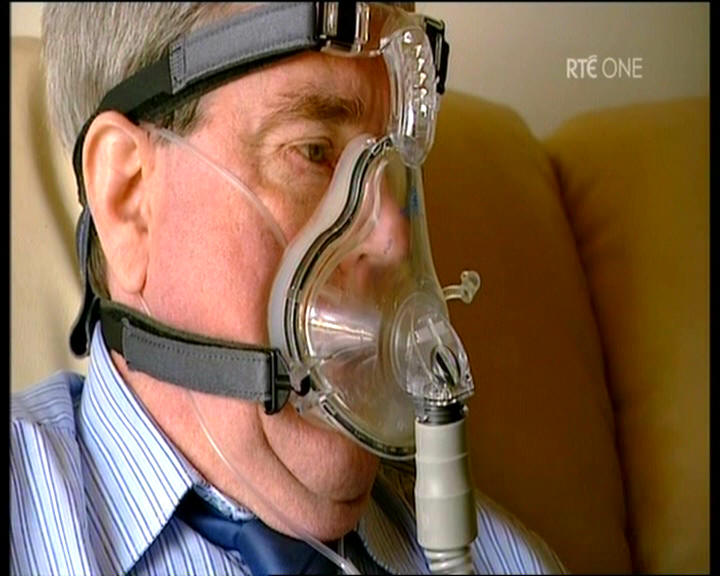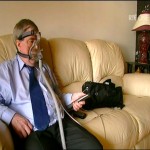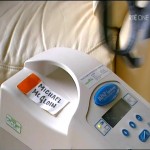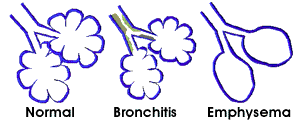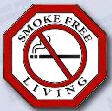“Smokers” By the time you have your first symptom your lungs are already damaged
What is C.O.P.D and how does it effect you
C.O.P.D.—Chronic Obstructive Pulmonary DiseaseC.O.P.D. is a debilitating lung disease that is progressive and is irreversible and is linked to smoking in most cases and affecting over 110,000 Irish people. C.O.P.D. is the second largest cause of respiratory deaths in Ireland. C.O.P.D. obstructs the airways, making breathing difficult. Patients with C.O.P.D. including those with Chronic Bronchitis and Emphysema are estimated to account for almost a quarter of deaths in Ireland. In Ireland about 7,000 people die each year from smoking-related diseases. This is 10 times more than the number killed each year in road incidents.
About a quarter of all regular smokers are killed prematurely by their smoking. Those killed loose an average 10-15 years of potential life. Smoking is a major cause of 90% of lung cancer deaths, 25% of deaths from heart disease and about 75% of deaths from C.O.P.D. Bronchitis and Emphysema. There are different stages of C.O.P.D. these being mild, moderate and severe.
Bronchitis and emphysema can occur separately but often develop together.
In Chronic bronchitis, the airways are narrowed by swelling and become infected with bacteria. The infection causes yellow or green sputum that blocks the narrow airways and makes breathing difficult.
In Emphysema, the tiny air sacs in the lungs become damaged. The walls of the air sacs (alveoli) stretch, rupture and loose elasticity which cause a decrease in the ability of the lungs to exchange carbon dioxide and oxygen and can lead to the patient collapsing.
Bronchiectasis is an abnormal stretching and enlarging of the respiratory passages caused by mucus blockage. When the body is unable to get rid of mucus, mucus becomes stuck and accumulates in the airways. The blockage and accompanying infection cause inflammation, leading to the weakening and widening of the passages. The weakened passages can become scarred and deformed, allowing more mucus and bacteria to accumulate, resulting in a cycle of infection and blocked airways.
Bronchiectasis patients are often given antibiotics for infection and bronchodilator medicines to open passages. There are also physical therapy techniques to help clear mucus. Lung transplants are also an option for severe cases. Fatalities are uncommon but may result from massive hemorrhage.
If lung infections are treated immediately, bronchiectasis is less likely to develop. Bronchiectasis patients should avoid cigarette smoke and other irritants and refrain from using sedatives. Vaccinations against measles, influenza and other infections could also be a good preventative measure.
Lung Fibrosis, also known as Idiopathic Pulmonary Fibrosis, results in the scarring of the lung tissue. This disease is caused by the reaction of the body to foreign elements. The Alveoli (air sacs) become inflamed and develop scars on the lung tissue in an attempt to repair itself.
Alveoli help the lungs breathe and release carbon dioxide. When the air sacs are scarred, the lung tissue is gradually replaced by fibrous tissue, which prevents the alveoli sacs from inhaling oxygen. The lung tissues harden causing shortness of breath, chronic dry cough, and discomfort in the chest. An inflammation of the lung tissue is a first sign of this disease.
This scarring of the lung tissue results in the permanent loss of transporting oxygen to the body. The more scarring of the tissue occurs, the less likely the patient will be able to breathe properly. The formation of scar tissue diminishes the ability of the alveolar sacs to function properly.
COPD causes strain on and enlargement of your heart, R/H Heart Failure, increased Blood Pressure in your Lungs (Pulmonary Hypertension).
Secondhand smoke (smoke that drifts off the end of a burning cigarette)
Passive smoke (smoke exhaled by someone who is smoking)
What causes C.O.P.D.?
The most important risk factor for C.O.P.D. is cigarette smoking. Passive exposure to cigarette smoke also contributes to respiratory symptoms and C.O.P.D. Other documented causes of C.O.P.D. include occupational dusts and chemicals (vapors, irritants, and fumes), and indoor air pollution.
C.O.P.D. Symptoms
Symptoms such as cough, mucus production and shortness of breath when walking even a short distance or climbing a stairs.
How is C.O.P.D. diagnosed
A diagnosis of C.O.P.D. should be considered if a person has symptoms of cough, mucus production and shortness of breath on exertion. However, the diagnosis should be confirmed by Lung Function Tests, which are used for diagnosis, assessment of severity and following the course of the disease. This is best done by spirometry which is performed in your local hospital.
Why is C.O.P.D. under-diagnosed
Most people with symptoms of C.O.P.D.do not visit a doctor and are not diagnosed with C.O.P.D. until the disease has progressed to the point that disability is advanced.
Educating patients and physicians to recognize symptoms of C.O.P.D. and initiating treatment early in the course of the disease are essential public health care aspects of this disease.
GP’s
“Some GPs and/or their practice nurses carry out spirometry in their own surgeries, others refer patients to their local hospitals for this test. In some areas the local hospitals do not have funding to provide direct access to general practitioners for spirometry and GPs sometimes have no option but to refer such patients to a city teaching hospital.”
Treatments
An effective treatment program includes four components of care:
(1) Assess and monitor disease
(2) Reduce risk factors
(3) Manage stable C.O.P.D. by both medication and non-medication interventions and
(4) Manage acute exacerbations – In the short-term worsening of C.O.P.D. symptoms that require medical attention at home or in the hospital. Smoking cessation is the single most effective – and slows its progression. Stable C.O.P.D. management includes use of bronchodilators for symptoms and influenza vaccines.
Life after C.O.P.D/ /Rehab Unit
A 12 week Pulmonary Rehabilitation Program is required. First of all you’re accessed and then you receive a one to one on exercise, advice and tips on how to save energy necessary for breathing. The Dietitian gives advice for a healthy diet. The OT explains relaxation and energy conservation. The pharmacist will explain your drugs and why you’re on them. You also view videos of people coping with C.O.P.D. Also Aerobics, Relaxation and oxygen therapy are explained. At the end of 12 weeks you will be accessed again.
Pulmonary rehabilitation requires an element of commitment from you too. It does work, but you have your part to play.
Each November on World Awareness Day, A major public awareness campaign on Chronic Obstructive Pulmonary Disease (C.O.P.D.) is held in most Hospitals.
If you have a debilitating chronic disease like C.O.P.D., it’s only logical for you to be fearful, depressed, frustrated, angry, and to suffer a deep loss of self-esteem. It’s even understandable to feel you have the right to some self-pity. But you also have the right to redirect those energies toward managing your disease and I’d like to help if I can.
